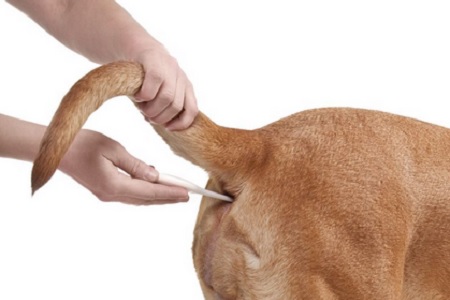Fever is one of the main reasons why we bring our pet to the vet. But what exactly can the symptoms be? lets investigate what are the causes and the treatments to fever in our pets and how we measure an animals body temperature.
The first thing we have to take into consideration is that fever is a symptom. This phrase can seem unimportant, but it is actually very relevant. A symptom, is indeed, the external manifestation of another hidden problem. It is our responsibility to find out what the real problem is by consulting a vet.
Fever can indicate a large number of problems and diseases in our animal. However, it can also appear at the same time in "normal" conditions as well.
how does temperature work?
Temperature in our body is maintained at constant values from our brain, especially from the hypothalamus which recognizes the perfect values for each of us. The range of values vary depending on the specie, age, sex and race.
Receptors are present on the surface of the skin and work exactly like small thermometers. They register external and internal temperature.
All of the information (about the temperature) collected by the receptors is sent to the hypothalamus where it will compare the temperature recorded with the registered levels (expected temperature levels). It behaves exactly like the thermostat in our house.
If the recorded temperature is higher than usual, the hypothalamus sends signal to the entire body to decrease it as soon as possible. It does this through heat loss.
On the contrary, if it is too low, it will try to preserve and safe all of the heat produced continuously.
It is essential for the hypothalamus to work properly. Otherwise, an excessively high temperature can severely damage the brain.
is it real fever?

At this point, it is essential to clarify the difference between fever and hyperthermia as we tend to confuse the two of them. Lets further investigate these terms.
Fever can be considered as an increase in body temperature for sure, but we only call it such when there is an infection or severe inflammation. In these cases, some substances named pyrogens, travel around the body and "block" the hypothalamus. Consequently, the temperature is free to rise.
On the contrary, hyperthermia has nothing to do with the hypothalamus whatsoever. It depends on the external temperature the animal is in. An example of this is when an animal remains in a hot environment for a long period of time and might experience heat strokes due to dehydration. Some extreme consequences can also lead to death.
Other than fever and hyperthermia, we might experience other situations (fortunately less dangerous) that can cause a temperature rise. This is because the animal produced excess heat and needs time to dissipate it. This is why we feel the animal so warm. These are some situations:
-
anxiety and stress;
-
visit to the vet (emotionally dramatic experience for some "sensitive animals");
-
excessive physical activity;
-
external temperatures higher than usual .
Causes of fever
Once your vet has determined that the cause of the rise in temperature is actually fever, it will start to investigate the origin of this increase. The main causes of fever include:
-
infections caused by bacteria, viruses or fungi;
-
infected wounds;
-
internal organ problem;
-
hidden pus cavities in the body;
-
immune system problems;
-
medicine that will cause temperature rise;
-
presence of parasites;
-
cancer;
-
recent surgery.
symptoms
When animals have fever, they usually show a series of symptoms, even if the temperature rise is slight. Some of the symptoms might be:
-
refuses to drink and eat;
-
doesn't move much;
-
sleeps often;
-
refuses to be touched or petted;
-
respiration is more frequent;
-
ears and nose are hotter when we touch them.
In the presence of any condition or diseases, some specific symptoms might add up to the list such as diarrhea, vomit, sneezes and abundant tearing.
How do we measure the temperature?
We can perfectly measure our animals temperature on our own to verify the conditions and avoid false alarms.
We need to have a digital thermometer. The ideal type is a quick one with flexible tip and with a display. The thermometer should also notify you through a noise that the operation is completed and you can remove it.
The first step is to disinfect the tip of the thermometer with some rubbing alcohol. Let the alcohol evaporate for a couple of seconds and them lubricate the tip with some oil or some regular vaseline to realize the operation comfortably and without any pain.
We should ask for someones help to keep the dog or cat still and then gently lift the tail and insert the thermometer in the first opening just under it, as well as the only one present in males.
1,5-2 cm are enough to indicate the animals body temperature. We must keep the thermometer slightly tilted so that it can touch the rectum walls.
How to interpret values
The ideal temperature is highly variable depending on the species, age and size of your animal. These are the main values:
-
baby dogs and baby cats : 38,8-39° C;
-
adult cats: 38-38,2° C;
-
small sized animals: 38,5-39,2° C;
-
big or huge sized dogs: 37,5-38,5° C.
What to do
Firstly, we must contact our vet. If necessary, wrap your pet around a blanket and bring them at a local clinic.
We must encourage our animal to drink to avoid dehydration. We must keep our animal warm and avoid contact with cold surfaces or the floor. An old blanket will be more than fine, we must not exaggerate.
Our medicine is totally forbidden for our animal and paracetamol is toxic for dogs and cats. Therefore, we must not give them any.
Rather, bring your dog to your vet that will examine its conditions of dehydration (inevitable with fever). Later, the vet will try to find the cause of the fever through a general visit and some blood tests as well. Subsequently, he will plan the therapy according to the problem.










